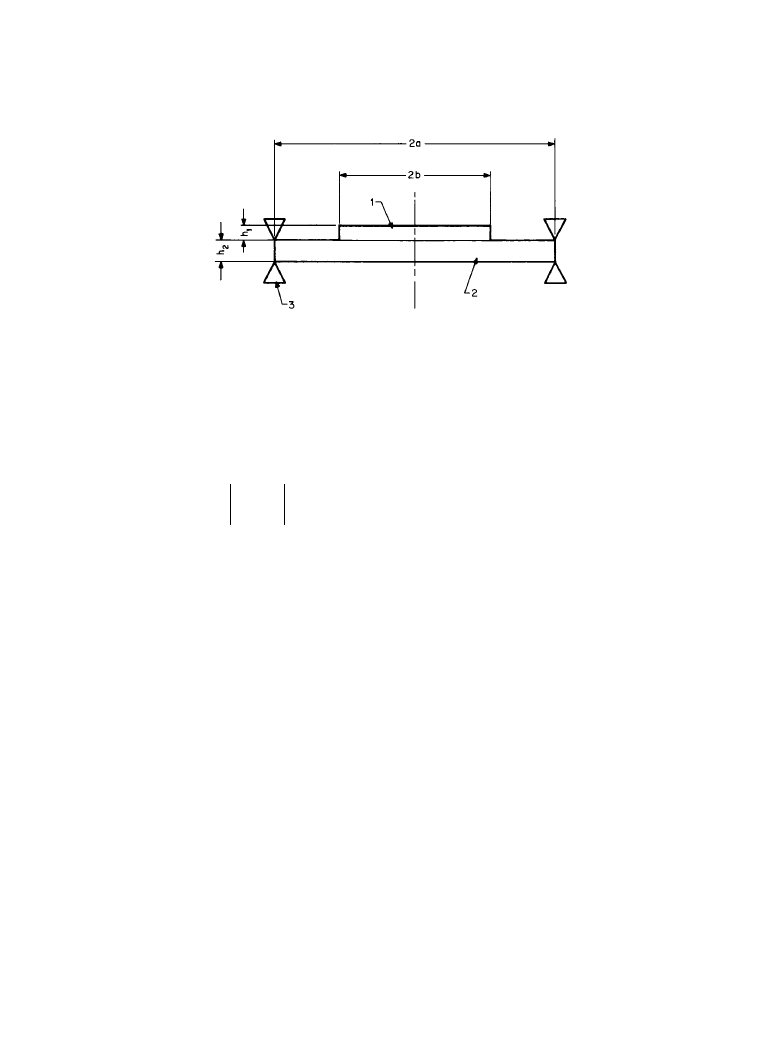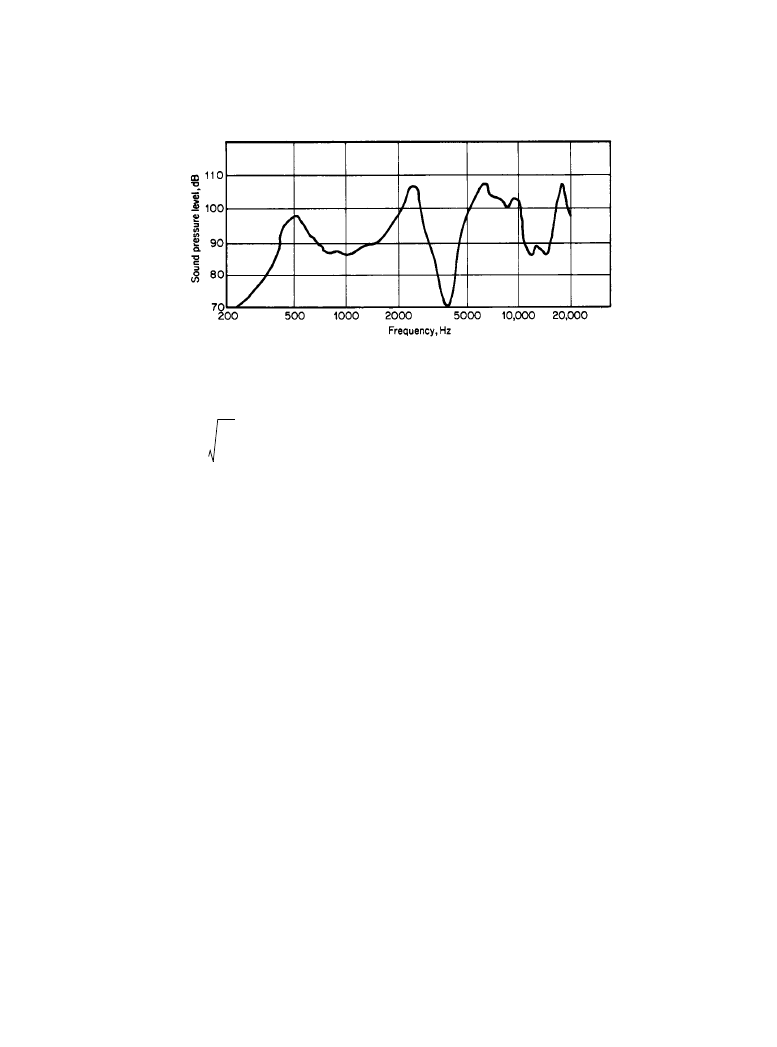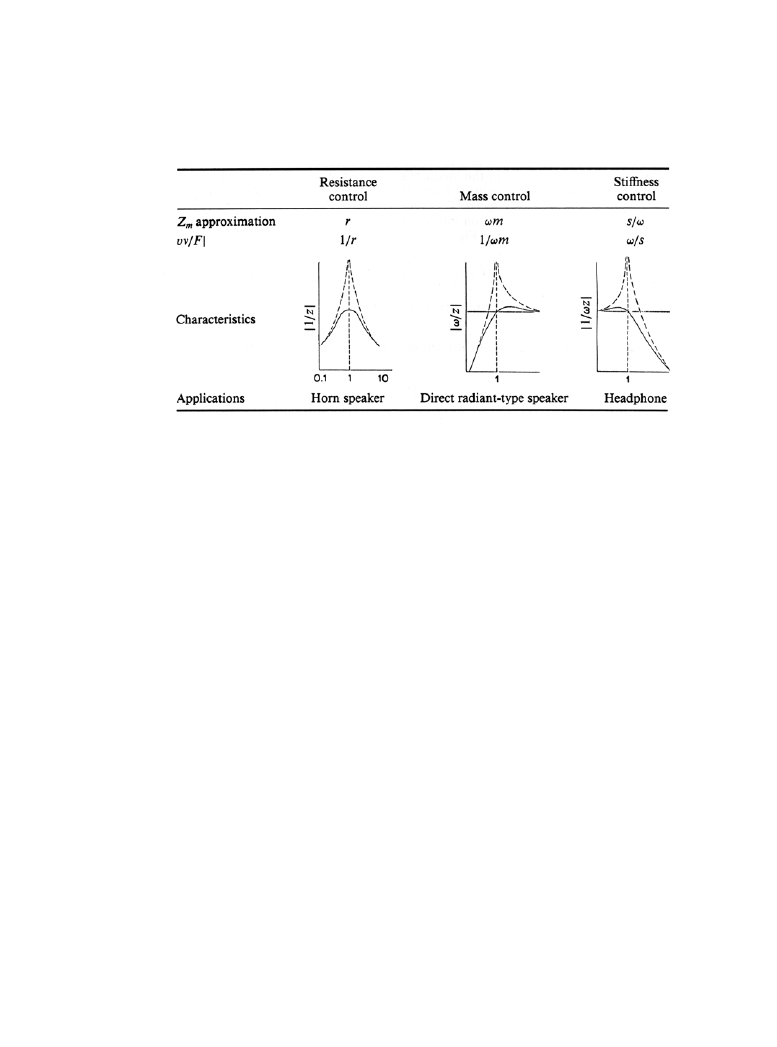ВУЗ: Казахская Национальная Академия Искусств им. Т. Жургенова
Категория: Книга
Дисциплина: Не указана
Добавлен: 03.02.2019
Просмотров: 21664
Скачиваний: 19

5-12 Sound Reproduction Devices and Systems
reliability and a reasonable price, is used as the piezoelectric element for the speaker. By using a
configuration such as shown in Figure 5.1.5, the output sound level and resonance frequency can
be determined. Power sensitivity q, when radian frequency
is calculated by
(5.1.24)
Where:
q
0
= power sensitivity
U
0
= volume velocity, m
3
/s
Z
e
= electrical impedance of piezoelectric element,
Ω
E
0
= input voltage, V
K
1
= constant
Assuming displacement at the piezoelectric element and laminated metal sheet to be
ξ ′ and
displacement at the peripheral metal part to be
ξ , U
0
is found as follows
(5.1.25)
Z, which is mainly a qualitative component, is determined by
(5.1.26)
Where:
ε = dielectric constant of piezoelectric element
η = b/a
ω 0
→
q
0
20log
K
1
U
0
Z
e
E
0
--------------------
=
U
0
2
πrξ '
0
b
∫
dr
2
πrξ
b
a
∫
dr
+
=
Z
K
2
πωε
33
T
------------------
h
1
a
2
η
2
----------
×
=
Figure 5.1.5
Simplified form of a monomorphic piezoelectric transducer. 1 = piezoelectric element
(
E
1
,
P
1
µ
1
); 2 = metal plate (
E
2
,
P
2
µ
2
); 3 = supporting ring.
Downloaded from Digital Engineering Library @ McGraw-Hill (www.digitalengineeringlibrary.com)
Copyright © 2004 The McGraw-Hill Companies. All rights reserved.
Any use is subject to the Terms of Use as given at the website.
Electroacoustic Transducers

Electroacoustic Transducers 5-13
K
2
= constant
To find the optimum condition of
η if µ
1
=
µ2 = µ with radius a, material thickness h = h
1
+ h
2
,
and the piezoelectric constant d
31
,
ε
T
33
constant, the following is obtained
(5.1.27)
(5.1.28)
(5.1.29)
Where:
α = Q
1
/Q
2
µ = Poisson ratio, defined as the charge density at any point divided by the absolute capacitivity
of the medium
From the above, it is found that
η = 0.5 to 0.8 is better. β is dependent on α, but when the rela-
tive sensitivity of various metals is compared, 0.2 <
β < 1.0; therefore, aluminum is the best. The
primary resonance frequency of the vibrator is
(5.1.30)
Where:
f
1
= primary resonance frequency, Hz
Q
2
= Young's modulus, N/m
2
P
2
= density, kg/m
3
Assuming radius
α, thickness h, and Poisson's ratio to be constant, C is determined by
(5.1.31)
where C = sound velocity, m/s. Furthermore, the resonance frequency of the vibrator is
expressed as follows:
U
0
Z
E
--------------
α 1 β
+
(
) β
1
αβ
+
-----------------------------
∝
µ 3 µ η 1 µ
+
(
)
–
+
[
]
1
µ
+
(
)C η
2
1
µ
–
(
)C 2 1
(
µ
2
) 1
3
2
---
ζ
3
4
---
ζ
2
+
–
–
+
+
-------------------------------------------------------------------------------------------------------------------------------
×
C
1
µ
2
–
(
) β
2
3
2
---
βζ
3
4
---
ζ
2
+
+
αβ 2µ 1 µ
–
(
) 1
3
2
---
ζ
–
3
4
---
ζ
2
+
+
=
ζ
1
αβ
2
–
(
) 1 αβ
+
(
)
=
f
1
2.22
2
h
1
2
πa
2
β
-------------------
Q
2
3p
2
1
µ
2
–
(
)
---------------------------- 1
3
2
---
ζ
–
3
4
---
ζ
+
=
f
1
C
1
3
2
---
ζ
–
3
4
---
ζ
2
+
β
⁄
∝
C
Q
2
P
2
⁄
=
Downloaded from Digital Engineering Library @ McGraw-Hill (www.digitalengineeringlibrary.com)
Copyright © 2004 The McGraw-Hill Companies. All rights reserved.
Any use is subject to the Terms of Use as given at the website.
Electroacoustic Transducers

5-14 Sound Reproduction Devices and Systems
(5.1.32)
Where:
m
0
= vibrator mass, kg
s
0
= vibrator stiffness, N/m
However, to reduce mechanical Q, a small
is preferable, and therefore aluminum is the
best material. Figure 5.1.6 shows the sound-pressure-frequency characteristics of a speaker with
this construction.
5.1.3
Control System and Its Acoustic Characteristics
For acoustic equipment, in the process of transforming electrical energy to acoustic energy, con-
version from the electrical system to the mechanical system and from the mechanical system to
the acoustic system is performed. The conversion process is expressed approximately by the
equation
(5.1.33)
The left-hand term shows the ratio of electrical input to sound pressure, which should be kept
constant regardless of frequency. However, the first term, the ratio of electrical input to driving
force, and the third term, the ratio of diaphragm velocity V to sound pressure P on the right, are
fixed by the conversion and radiation systems in the relationship with frequency. For example,
the sound pressure of a direct-radiation type of speaker increases in proportion to frequency if
the velocity V is constant. Consequently, if V/F decreases with frequency, the ratio is not related
to frequency as a whole even when F/E is constant. This corresponds to a mass when the vibrat-
f
1
1
2
π
------
s
o
m
o
------
=
s
0
m
0
×
P
E
---
F
E
---
V
F
---
×
P
V
---
×
=
Figure 5.1.6
Frequency characteristics of a typical monomorphic piezoelectric transducer.
Downloaded from Digital Engineering Library @ McGraw-Hill (www.digitalengineeringlibrary.com)
Copyright © 2004 The McGraw-Hill Companies. All rights reserved.
Any use is subject to the Terms of Use as given at the website.
Electroacoustic Transducers

Electroacoustic Transducers 5-15
ing system is regarded as a single resonance system, which is called mass control. Likewise,
when V/F becomes unrelated to frequency, both the resistance control and the frequency
increase; this is called stiffness control. Table 5.1.2 summarizes these characteristics.
5.1.4
Bibliography
Beranek, L. L.: Acoustics, McGraw-Hill, New York, N.Y., pg. 183, 1954.
Hayasaka, T., et al.: Onkyo-Kogaku Gairon (An Introduction to Sound and Vibration), Nikkan
Kogyo Shinbunshya, pg. 67, 1973 (in Japanese).
Hayasaka, T., et al.: Onkyo-Shindo Ron (Sound and Vibration), Maruzen Kabushikigaishya, pg.
201, 1974 (in Japanese).
Kinsler, L. E., et al.: Fundamentals of Acoustics, Wiley, New York, N.Y., pg. 348, 1982.
Olson, H. F.: Elements of Acoustical Engineering, Van Nostrand, Princeton, N.J., pg. 124, 1957.
Table 5.1.2 Three Control Systems
Downloaded from Digital Engineering Library @ McGraw-Hill (www.digitalengineeringlibrary.com)
Copyright © 2004 The McGraw-Hill Companies. All rights reserved.
Any use is subject to the Terms of Use as given at the website.
Electroacoustic Transducers

Downloaded from Digital Engineering Library @ McGraw-Hill (www.digitalengineeringlibrary.com)
Copyright © 2004 The McGraw-Hill Companies. All rights reserved.
Any use is subject to the Terms of Use as given at the website.
Electroacoustic Transducers